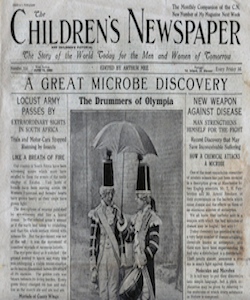Do you believe in the power of reading for children? Have you noticed how the shelves of children’s sections of bookshops are now bursting with fantastic new titles all beautifully designed for every level and interest of a child? This has been widely regarded as a new golden age of children’s literature and for Clementine Macmillan-Scott and her team at Scoop Magazine, it’s a truly exciting thing to be part of.
 Reading in print
Reading in print
As well as the fact that more stories, both fiction and non-fiction are being created, the printed book market is also booming. As adults we may all have worries about the pervasiveness of the screen in children’s lives. Of course we know that the online world provides an incredible gateway to knowledge but it also brings some worries with it.
The children’s book market
What we are finding however is that children still love reading in print! In the UK nearly £1 in every £4 spent on print titles is on a children’s book, a market share of 24%. According to The Bookseller: “Children are now reading more and want to read print.” This is confirmed by the Publishers Association, which recently reported that book sales for the previous year had jumped 7% to £4.8bn, and data suggests that this has been driven by that whopping 16% jump in revenues from children’s publishing.
 Magazines
Magazines
In the midst of all this growth in printed books we are also seeing other types of publications such as magazines becoming more and more popular in the UK and abroad. In the UK there are of course many plastic-coated, TV-branded magazines that line the shelves of supermarkets. But there are also some wonderful magazines and newspapers for children today, all independently run and beautifully put together and designed. All our readers are often also fans of Aquila, Anorak, Okido, The Week Junior, and they often read First News at school. Each of these magazines has its own angle and age group, they might be design-led, or based on current affairs or educational.
The original
The idea for Scoop magazine came about as I was researching for a book about childhood in the 1930’s. There was a wonderful UK newspaper called The Children’s Newspaper which ran from 1919 to 1965, when it merged with Look and Learn. The founder and editor of the paper, Arthur Mee, had a clear objective, to inform children through narrative. One story in particular caught my eye, which was about children who lived on canal boats in London and how they went to school. He was telling a story and also giving his readers a sense of the wider world. I wondered if anything like this existed today and I began to do a different sort of research.
 Scoop Magazine
Scoop Magazine
The last year since launching the story of our success at Scoop has illustrated the resilience of print and paper in the face of the digital revolution. We publish the best story telling we can get our hands on and have included establishment heavyweights such as the playwright Tom Stoppard, plus children’s writers such as Raymond Briggs, author of Fungus The Bogeyman and the Children’s laureate Chris Riddell. And our readers are growing by the hundreds each month.
The importance of stories
This is a truly exciting time for children’s literature and a time for children from all over the world to see themselves in books and stories as well as to read stories in which children who they consider different from themselves feature in starring roles. As Sarah Odedina, the editor of Scoop says:
“Today’s child in today’s world wants choice, wants the freedom to choose, wants to see their world reflected in the words that they read and wants to hear from their peers and friends about what is good. If we as publishers, writers, librarians and teachers don’t recognise this we will not be able to ensure that the love of reading that we so want to share is indeed passed on. I think we are all getting much better, even if there is still some way to go.”
Along with masses of publishers, teachers and parents out there we are committed to giving children as many ways into as many different stories as possible and to inspire them with a love of reading. May the golden age live on!
Thanks Clementine! To get hold of a copy of Scoop, go to the website to subscribe, buy a back issue, or have a look for a local stockist. Or you can always email hello@scoopthemag.co.uk for more information.




